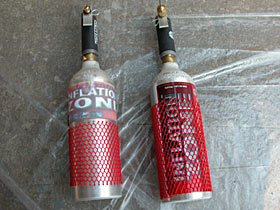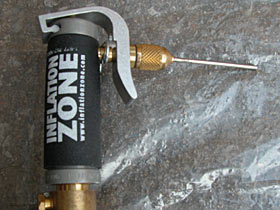|
|
|||||||
|
Typically, most four-wheelers use 10lb. tanks. The tanks are usually mounted on brackets inside of the vehicles and can easily be used to air up tires, run air tools, blow dust off of parts during repairs, and even run air lockers. But what if you don't have room in your rig or you just want to carry a tank to use for emergencies? Inflation Zone has the answer. The CFH-20 is a 20 oz. CO2 canister with a REHVAC variable output regulator. The regulator is operated by a trigger and can release 0-100 psi when activated. The kit also comes with a three foot long hose to connect to a tire, a needle for inflating your favorite sports ball, and a cone tip. If you're wondering just how much a 20 oz. tank can put out , it has the equivalent of five 5 gallon air tanks charged to 125 psi and packs an amazing 11 cubic feet of volume. So while 20 oz. may be only 1/8 the size of a 10 lb. tank, this little wine bottle-sized tank can still put out enough to get you off the trail if you need it.
Obviously, one of the first things we wanted to know was exactly how much this little tank could do, so we headed out to the Jeep for a test. Our test tire is a BFGoodrich Mud Terrain 31x10.50x15. We made sure it was at 30psi prior to our testing. The test would be very basic. We would air down to 10psi and then use the tank to inflate back up to 30psi. Then we'd repeat until the tank was empty.
We assembled the regulator onto the tank and attached the hose. What we immediately realized was that there was no easy way to check pressure while we aired up the tire. The reason is that the other end of the hose is threaded and must be screwed onto the tire valve. This is contrary to most of the other air chucks we've used which either press on momentarily or clamp on with a lever. The nice thing about the Inflation Zone setup, though, is that no CO2 is lost during inflation. The con, of course, is that you must continuously thread and unthread the connection to test pressure. You also cannot put a guage in-line on the hose.
The tank has red netting around it to keep your hand from sticking to the tank during use, due to the fact that the tank exterior freezes during the extended release of CO2 from the tank. The netting certainly helped keep my hand from fusing to the tank, which I certainly appreciated. What didn't work out so well, though, was the Inflation Zone label, which was printed on an ink jet printer. Once the ice melted, the water ran through the label and the ink ran. No big deal, as the label was easy enough to peel off and the tank looks better naked, anyway. (see update below) So it was immediately obvious to us that the CFH-20 is not the end-all-be-all of CO2 tanks for airing up large off-road tires after a trailride. Of course, we never expected it to be, either, due to its size. The tank would prove to be quite useful for emergency situations, though, and we feel like it could be a great addition to any 4x4 that needs emergency air but is space-challenged. It would also be a wonderful accessory to keep in your street-only truck, SUV or car, as in these cases, the tank would be way more than you'd ever need in most situations.
In order to use the tank for powering a blow gun, we will need to either order an SS-08 from Inflation Zone for $9.99 or find an adapter to use our blow gun attachment we already own or fabricate a new hose to attach to the tank. So far, we've had no luck finding the proper size parts to do it ourselves, so we'll probably just order the SS-08 and be done with it. (see update below) Inflation Zone sells many different models and kits of tanks, ranging from 9 ounce tanks all the way up to 10 pound tanks. The various kits are made up different accessories for the most part. For example, the MK-5 Deluxe Carpenter's Kit includes two 20 oz. tanks, a variable regulator, an air hose for tires, and a pneumatic accessory hose for running air tools. A single tank is said to be able to shoot 550 nails from a gun. The MBK-8 ten pound tank includes both a three and a six foot tire hose, a blow gun, and a 0-250psi adjustable regulator with dual guages. With many different kit choices available, Inflation Zone should have a tank to fit your needs. Update:
|
|||||||
|
Help spread the ROCKCRAWLER world!
|
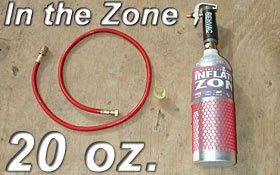
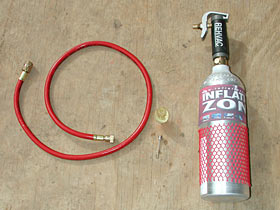 By
now, you've certainly heard of the virtues of the various CO2
tanks out of the market. You probably already know that CO2
packs a whole lot more punch than regular old air. If you don't
already know that, then you're missing out, so listen up!
By
now, you've certainly heard of the virtues of the various CO2
tanks out of the market. You probably already know that CO2
packs a whole lot more punch than regular old air. If you don't
already know that, then you're missing out, so listen up! 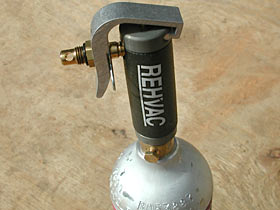 When
our system arrived, I was very excited to pop open the box and
check it out. The tank was nice and shiny and eager to be filled,
so I made a trip to my usual CO2
shop, where I quickly learned that this tank is what they refer
to as a "paint ball tank." They informed me that they
could not fill it because of the connector being a different size
than the typical larger tanks. They were, however, kind enough
to tell me who in town could fill the tank for me. When we fill
our 10 pound tanks, it costs us $5. When we went to the hunting
shop to fill our new twenty, we paid $.25/ounce, which worked
out to $5.40 including tax.
When
our system arrived, I was very excited to pop open the box and
check it out. The tank was nice and shiny and eager to be filled,
so I made a trip to my usual CO2
shop, where I quickly learned that this tank is what they refer
to as a "paint ball tank." They informed me that they
could not fill it because of the connector being a different size
than the typical larger tanks. They were, however, kind enough
to tell me who in town could fill the tank for me. When we fill
our 10 pound tanks, it costs us $5. When we went to the hunting
shop to fill our new twenty, we paid $.25/ounce, which worked
out to $5.40 including tax.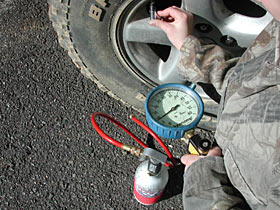
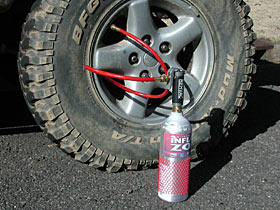
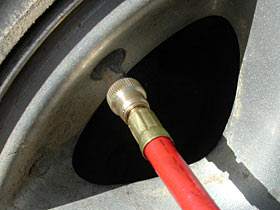 Connection
aside, the tank's trigger-actuated valve worked quite well and
was easy to use for small spurts of CO2.
During our test, we got exactly two tires inflated from 10 to
30psi. The first tire took about 60 seconds, while the second
took a bit longer, as we eeked out the last few bits of CO2
from the tank.
Connection
aside, the tank's trigger-actuated valve worked quite well and
was easy to use for small spurts of CO2.
During our test, we got exactly two tires inflated from 10 to
30psi. The first tire took about 60 seconds, while the second
took a bit longer, as we eeked out the last few bits of CO2
from the tank.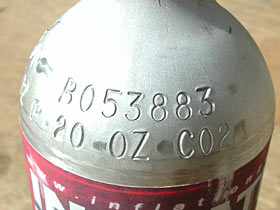 For
our Jeep, we prefer our 10 pound tanks, so those will remain in
the Jeep. Inflation Zone sells these tanks as well, but did not
send one for review. Our CFH-20 will likely find itself riding
in our Xterra during family trips to be used in case of emergenices,
and will also find itself a home on our shop workbench and in
our radio control truck travel box. It is the perfect size to
use for compressed air for blowing off parts on the bench and
blowing loose dirt and debris from our r/c truck.
For
our Jeep, we prefer our 10 pound tanks, so those will remain in
the Jeep. Inflation Zone sells these tanks as well, but did not
send one for review. Our CFH-20 will likely find itself riding
in our Xterra during family trips to be used in case of emergenices,
and will also find itself a home on our shop workbench and in
our radio control truck travel box. It is the perfect size to
use for compressed air for blowing off parts on the bench and
blowing loose dirt and debris from our r/c truck.